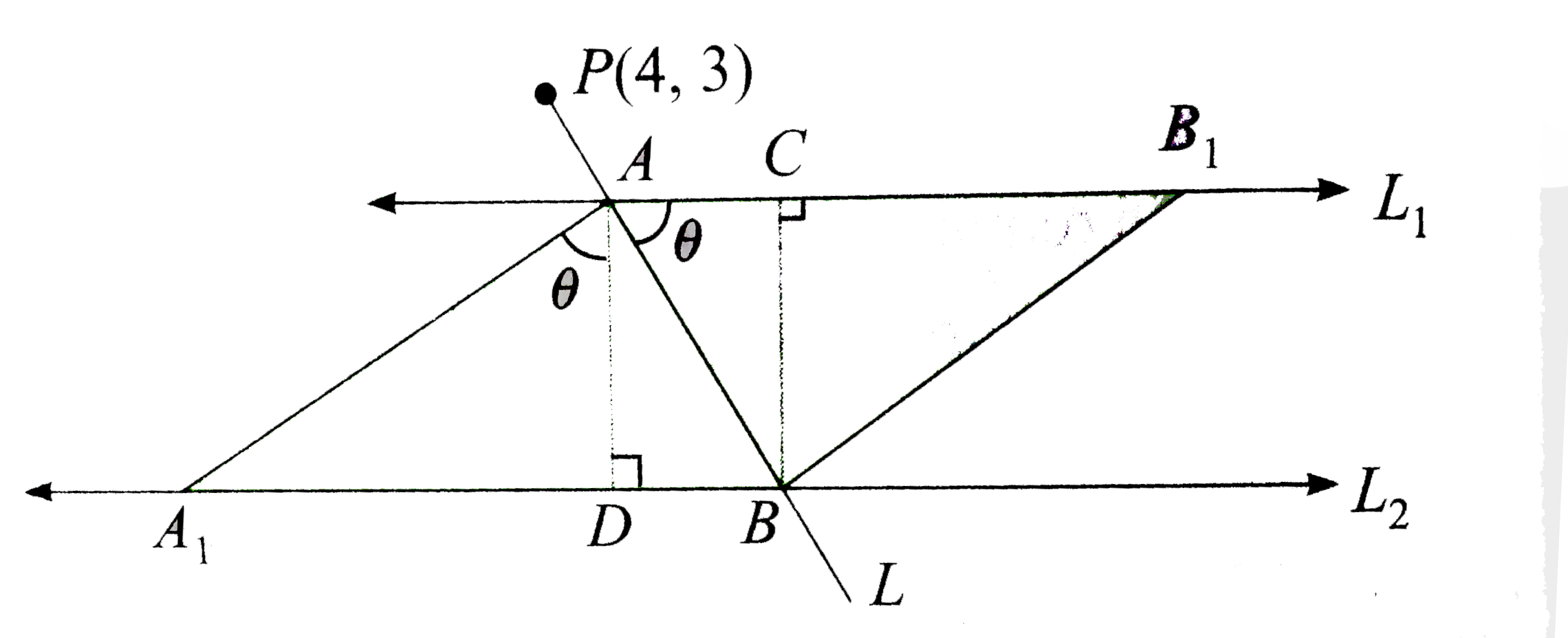A line L is a drawn from P(4,3) to meet the lines L−1andL2 given by 3x+4y+5=0 and 3x+4y+15=0 at points AandB , respectively. From A , a line perpendicular to L is drawn meeting the line L2 at A1. Similarly, from point B1. Thus, a parallelogram ∀1BB1 is formed. Then the equation of L so that the area of the parallelogram ∀1BB1 is the least is x−7y+17=0 7x+y+31=0 x−7y−17=0 x+7y−31=0

The given lines (L1 andL2) are parallel and the distance between them (BC or AD) is (15-5)/5 = 0 units. Let ∠BAC=θ. So, AB = BC cosec θ=2 cosec θ and AA1=AD sec θ=2 sec θ. Now, the area of parallelogram AA1BB1 is
Δ=AB×AA1=4sec θ cosecθ
=8sin2θ
Clearly,Δ is the least forθ=π/4. Let the slope of AB be m. Then,
tan45∘=∣∣∣m+3/41−(3m/4)∣∣∣
or 4m+3=±(4−3m)orm=17or−7
Hence, the equation of L is
x-7y+17=0
or 7x + y -31=0
Topper's Solved these Questions
- STRAIGHT LINESBOOK - CENGAGECHAPTER - STRAIGHT LINESEXERCISE - Exercise 2.1
23 Videos
- STRAIGHT LINESBOOK - CENGAGECHAPTER - STRAIGHT LINESEXERCISE - Exercise 2.2
4 Videos
- STRAIGHT LINEBOOK - CENGAGECHAPTER - STRAIGHT LINEEXERCISE - Multiple Correct Answers Type
8 Videos
- THEORY OF EQUATIONSBOOK - CENGAGECHAPTER - THEORY OF EQUATIONSEXERCISE - JEE Advanced Previous Year
9 Videos
Similar Questions
A line is a drawn from P(4,3) to meet the lines L1andl2 given by 3x+4y+5=0and3x+4y+15=0 at points AandB respectively. From A , a line perpendicular to L is drawn meeting the line L2 at A1 Similarly, from point B1 Thus a parallelogram ∀1BB1 is formed. Then the equation of L so that the area of the parallelogram ∀1BB1 is the least is (a) x−7y+17=0 (b) 7x+y+31=0 (c) x−7y−17=0 (d) x+7y−31=0
View SolutionA line is a drawn from P(4,3) to meet the lines L1andl2 given by 3x+4y+5=0and3x+4y+15=0 at points AandB respectively. From A , a line perpendicular to L is drawn meeting the line L2 at A1 Similarly, from point B1 Thus a parallelogram ∀1BB1 is formed. Then the equation of L so that the area of the parallelogram ∀1BB1 is the least is (a) x−7y+17=0 (b) 7x+y+31=0 (c) x−7y−17=0 (d) x+7y−31=0
View Solution
Knowledge Check
A variable line L is drawn through O(0,0) to meet the line L1 and L2 given by y-x-10 =0 and y-x-20=0 at Points A and B, respectively.
Locus of P, if OP2=OA×OB, isA(y−x)2=100B(y+x)2=50C(y−x)2=200Dnone of theseThe three lines l1=4x−3y+2=0,l2=3x+4y−4=0 and l3=x−7y+6=0
Aform a rt. angled isosceles triangleBform a rt. Angled triangleCare concurrentDNone
A variable line L drawn through O(0,0) to meet line l1: y-x-10=0 and L2:y-x-20=0 at the point A and B respectively then locus of point p is ' such that (OP)2=OA.OB,
View SolutionFind the values of the parameter a so that the point (a, 2) is an interior point of the triangle formed by the lines x+y-4=0, 3x-7y-8=0and 4x-y-31 = 0.
View SolutionConsider two lines L1andL2 given by x−y=0 and x+y=0 , respectively, and a moving point P(x,y). Let d(P,L1),i=1,2, represents the distance of point P from the line Lt If point P moves in a certain region R in such a way that 2≤d(P,L1)+d(P,L2)≤4 , find the area of region R.
View SolutionConsider two lines L1andL2 given by x−y=0 and x+y=0 , respectively, and a moving point P(x,y). Let d(P,L1),i=1,2, represents the distance of point P from the line Lt If point P moves in a certain region R in such a way that 2≤d(P,P1)+d(P,L1)≤4 , find the area of region R.
View SolutionLet L1:x+y−3=0 and L2:7x−y+5=0 be two given lines. Let image of every point on L1, with respect to a line L lies on L2 then possible equation of L can be :
View SolutionConsider two lines L1andL2 given by a1x+b1y+c1=0anda2x+b2y+c2=0respectivelywherec1andc2≠0, intersecting at point P.A line L3 is drawn through the origin meeting the lines L1andL2 at AandB, respectively, such that PA=PB . Similarly, one more line L4 is drawn through the origin meeting the lines L1andL2 at A1andB2, respectively, such that PA1=PB1. Obtain the combined equation of lines L3andL4.
View Solution
